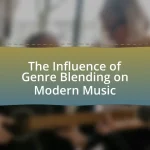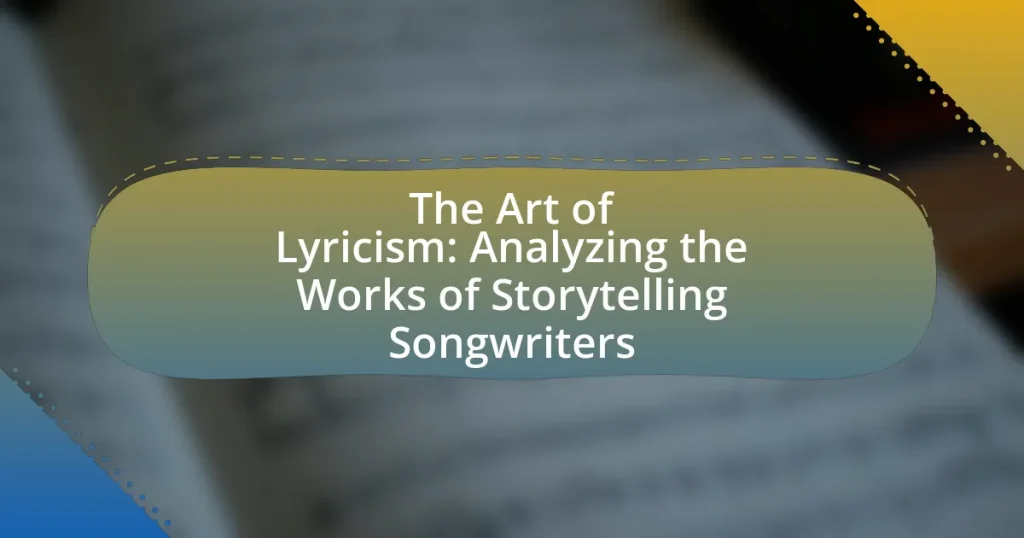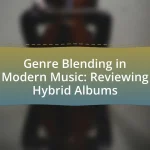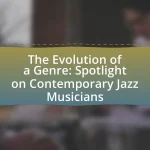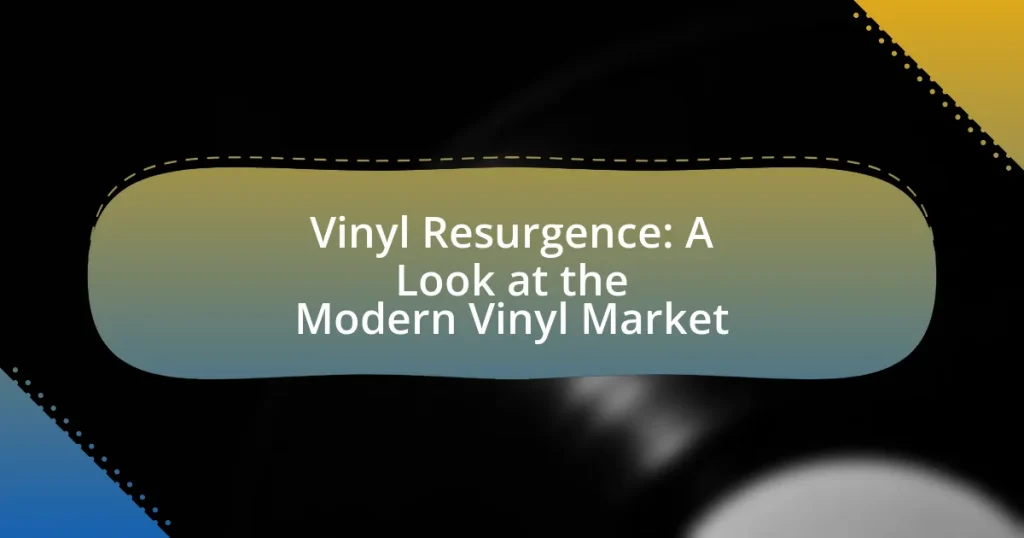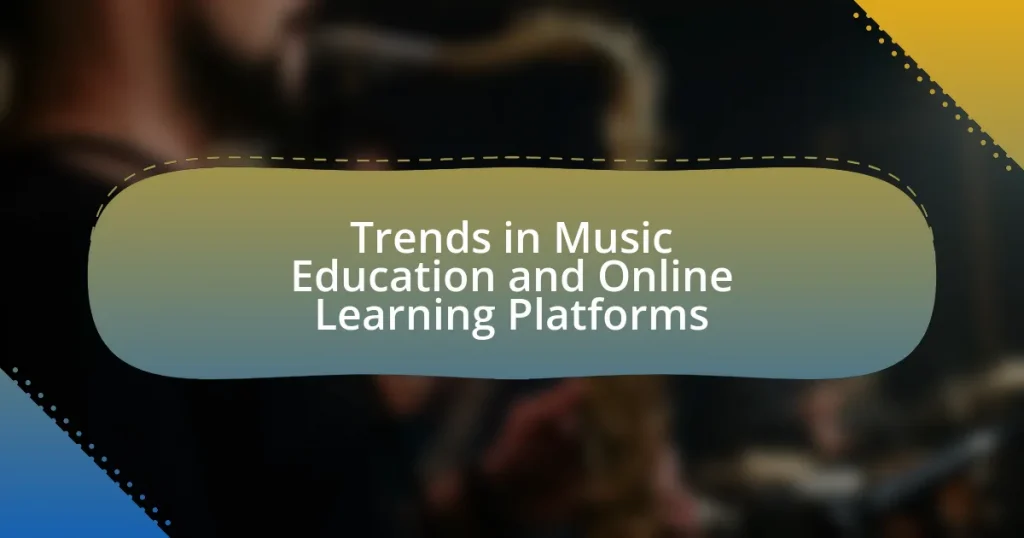The article focuses on the art of lyricism in storytelling songwriting, highlighting how songwriters craft lyrics that convey narratives, evoke emotions, and create vivid imagery. It examines the key elements of effective lyrical storytelling, including emotional resonance, character development, and coherent narrative structure, using examples from influential artists like Bob Dylan, Taylor Swift, and Joni Mitchell. The piece also discusses the importance of lyricism in music, its impact on listener engagement, and strategies for aspiring songwriters to enhance their lyrical creativity and originality. Additionally, it addresses common pitfalls to avoid and best practices for writing compelling lyrics that resonate with audiences.
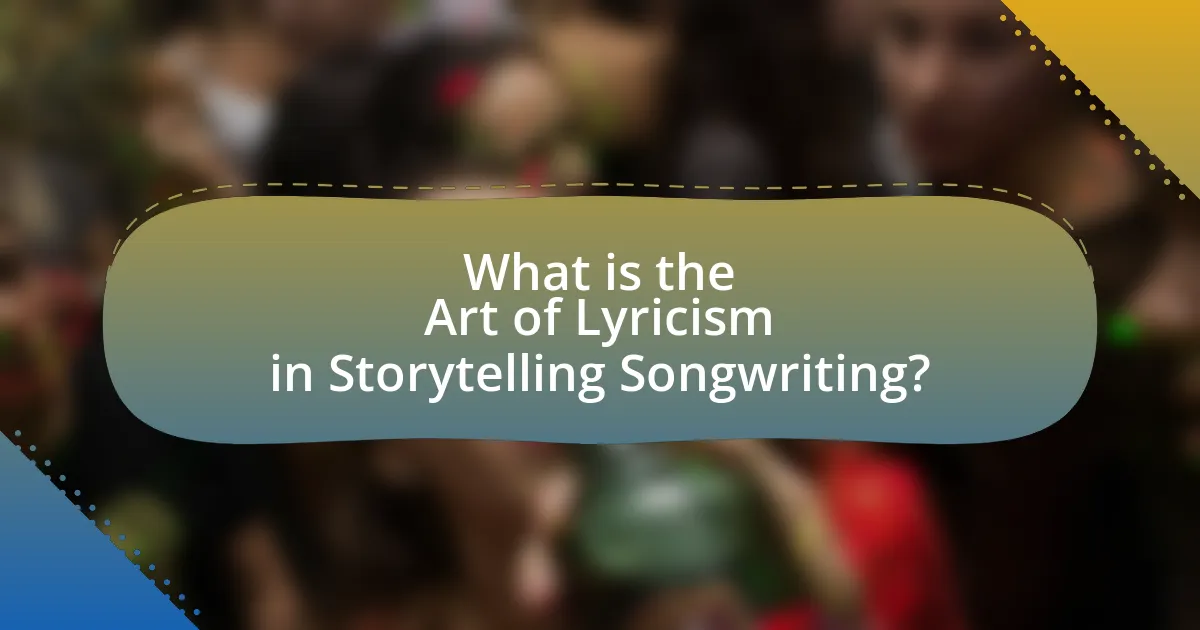
What is the Art of Lyricism in Storytelling Songwriting?
The art of lyricism in storytelling songwriting involves crafting lyrics that convey a narrative, evoke emotions, and create vivid imagery. This form of songwriting combines poetic techniques with storytelling elements, allowing songwriters to engage listeners through relatable themes and character development. For instance, artists like Bob Dylan and Taylor Swift exemplify this art by using personal experiences and detailed storytelling to connect with their audience, demonstrating that effective lyricism can transform a song into a compelling narrative experience.
How does lyricism enhance storytelling in songs?
Lyricism enhances storytelling in songs by providing a structured narrative that conveys emotions, themes, and character development. Through the use of vivid imagery, metaphors, and rhythmic patterns, songwriters can create a compelling storyline that resonates with listeners. For instance, Bob Dylan’s “Tangled Up in Blue” employs intricate lyrics to weave a complex tale of love and loss, illustrating how detailed storytelling can evoke deep emotional responses. This technique not only engages the audience but also allows for a richer interpretation of the song’s message, demonstrating the power of lyricism in transforming music into a narrative art form.
What are the key elements of effective lyrical storytelling?
The key elements of effective lyrical storytelling include vivid imagery, emotional resonance, character development, and a coherent narrative structure. Vivid imagery allows listeners to visualize scenes and emotions, enhancing engagement; for example, Bob Dylan’s use of descriptive language in “Tangled Up in Blue” paints a clear picture of the story’s setting and characters. Emotional resonance connects the audience to the narrative, as seen in Adele’s “Someone Like You,” where the themes of heartbreak are universally relatable. Character development is crucial, as it helps listeners invest in the story; in “The River” by Bruce Springsteen, the protagonist’s journey reflects broader societal issues. Lastly, a coherent narrative structure ensures that the story flows logically, making it easier for listeners to follow; this is exemplified in Taylor Swift’s “The Last Great American Dynasty,” which tells a complete story with a clear beginning, middle, and end. These elements work together to create compelling and memorable lyrical narratives.
How do emotions play a role in lyrical storytelling?
Emotions are central to lyrical storytelling as they drive the narrative and connect the listener to the song’s themes. Through the use of vivid imagery, relatable experiences, and expressive language, songwriters evoke feelings that resonate with audiences, enhancing the overall impact of the story. For instance, studies show that songs that convey strong emotions, such as love or heartbreak, often lead to deeper listener engagement and memorability, as evidenced by the popularity of emotionally charged tracks in music charts. This emotional connection not only enriches the storytelling but also fosters a sense of shared experience between the artist and the audience.
Why is lyricism important in music?
Lyricism is important in music because it conveys emotions, tells stories, and connects listeners to the artist’s experiences. The words in a song often serve as a vehicle for deeper meaning, allowing audiences to relate to themes of love, struggle, and identity. For instance, Bob Dylan’s lyrics in “Blowin’ in the Wind” address social issues and provoke thought, demonstrating how powerful lyrics can inspire change and reflection. Additionally, studies show that songs with meaningful lyrics can enhance listener engagement and emotional response, reinforcing the significance of lyricism in creating memorable and impactful music.
What impact does lyricism have on listener engagement?
Lyricism significantly enhances listener engagement by creating emotional connections and fostering relatability. When song lyrics convey personal stories, vivid imagery, or universal themes, they resonate with listeners, prompting deeper emotional responses. Research indicates that songs with meaningful lyrics can lead to increased listener retention and sharing behavior, as individuals are more likely to connect with and remember music that reflects their own experiences or emotions. For instance, a study published in the Journal of Consumer Research found that consumers are more likely to engage with brands that use storytelling in their marketing, paralleling how storytelling in lyrics can captivate audiences and encourage active listening.
How does lyricism differentiate artists in the music industry?
Lyricism differentiates artists in the music industry by showcasing their unique storytelling abilities and emotional depth. Artists who excel in lyricism often create memorable narratives that resonate with listeners, allowing them to connect on a personal level. For instance, Bob Dylan’s intricate lyrics have earned him a Nobel Prize in Literature, highlighting the impact of well-crafted words in music. Additionally, artists like Kendrick Lamar use lyricism to address social issues, setting them apart from their peers and establishing a distinct voice within the genre. This emphasis on lyrical content not only enhances artistic identity but also influences audience engagement and critical acclaim.
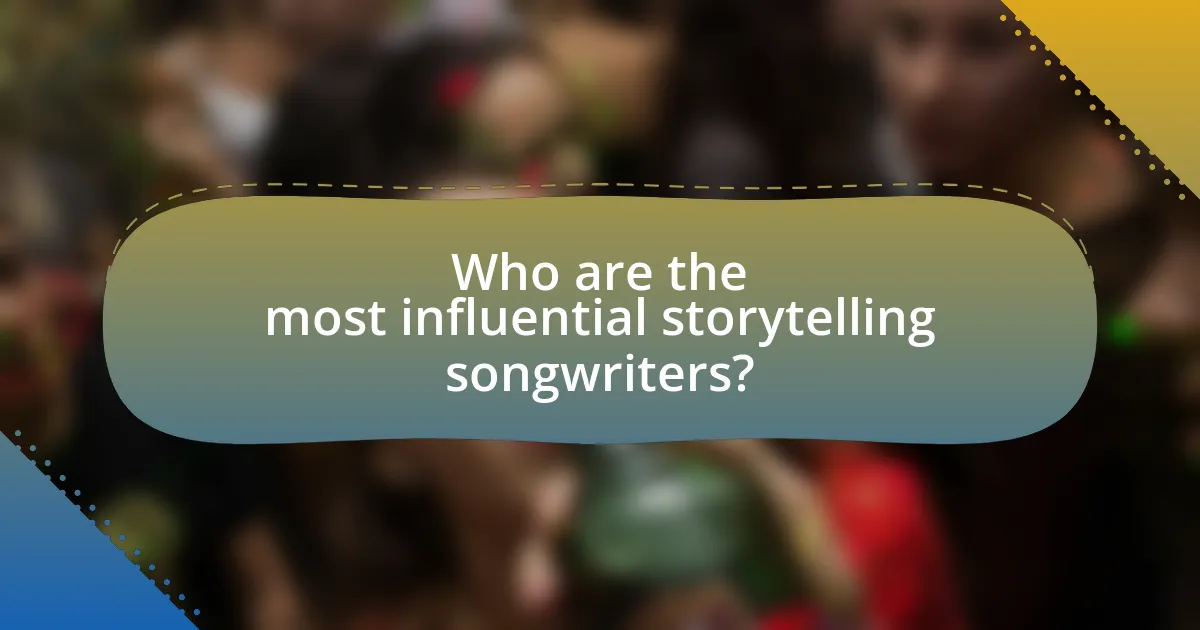
Who are the most influential storytelling songwriters?
The most influential storytelling songwriters include Bob Dylan, Johnny Cash, and Joni Mitchell. Bob Dylan is renowned for his profound lyrics that often reflect social and political themes, earning him the Nobel Prize in Literature in 2016. Johnny Cash’s narrative style in songs like “A Boy Named Sue” showcases character-driven storytelling, while Joni Mitchell’s intricate lyrics in tracks such as “A Case of You” reveal deep emotional landscapes. These artists have significantly shaped the craft of songwriting through their ability to weave compelling narratives into music.
What characteristics define a great storytelling songwriter?
A great storytelling songwriter is defined by their ability to create vivid imagery, develop relatable characters, and convey emotional depth through their lyrics. These songwriters skillfully use descriptive language to paint scenes that listeners can visualize, making the story come alive. They often incorporate personal experiences or universal themes, allowing audiences to connect with the narrative on a deeper level. Additionally, effective storytelling songwriters utilize structure and pacing to enhance the unfolding of the story, ensuring that the lyrics flow seamlessly and maintain listener engagement. This combination of techniques has been exemplified by artists like Bob Dylan and Taylor Swift, who are renowned for their narrative-driven songs that resonate widely with audiences.
How do personal experiences shape the narratives in their lyrics?
Personal experiences significantly shape the narratives in songwriters’ lyrics by providing authentic emotional depth and relatable themes. Songwriters often draw from their own life events, struggles, and triumphs, which allows them to create vivid imagery and genuine storytelling. For instance, artists like Taylor Swift and Eminem frequently reference their personal relationships and challenges, making their lyrics resonate with listeners on a deeper level. This connection is supported by research indicating that autobiographical elements in music enhance listener engagement and emotional response, as seen in studies published in the Journal of Music Psychology.
What techniques do they use to convey their stories?
Storytelling songwriters use techniques such as vivid imagery, narrative structure, and emotional resonance to convey their stories. Vivid imagery allows listeners to visualize scenes and emotions, enhancing engagement; for example, Bob Dylan often employs detailed descriptions that paint a picture in the listener’s mind. Narrative structure organizes the song into a coherent storyline, guiding the audience through a beginning, middle, and end, as seen in Johnny Cash’s “A Boy Named Sue.” Emotional resonance connects the audience to the characters and situations, making the story relatable, which is evident in Taylor Swift’s personal storytelling approach. These techniques collectively create a powerful storytelling experience in music.
Which songwriters have made significant contributions to lyricism?
Bob Dylan, Leonard Cohen, and Joni Mitchell are songwriters who have made significant contributions to lyricism. Bob Dylan’s work, particularly in songs like “Blowin’ in the Wind,” showcases profound social commentary and poetic depth, earning him the Nobel Prize in Literature in 2016. Leonard Cohen’s lyrics, exemplified in “Hallelujah,” blend spirituality and existential themes, establishing him as a master of lyrical storytelling. Joni Mitchell’s songs, such as “A Case of You,” are celebrated for their emotional honesty and vivid imagery, influencing countless artists and redefining the boundaries of songwriting. These songwriters have not only shaped popular music but have also elevated lyricism to an art form.
What are some iconic songs that exemplify storytelling through lyrics?
Some iconic songs that exemplify storytelling through lyrics include “The River” by Bruce Springsteen, “The Night the Lights Went Out in Georgia” by Vicki Lawrence, and “Fast Car” by Tracy Chapman. “The River” narrates the struggles of working-class life and lost dreams, while “The Night the Lights Went Out in Georgia” tells a tale of betrayal and injustice in a Southern setting. “Fast Car” depicts a yearning for escape and a better life, capturing the complexities of relationships and aspirations. Each of these songs uses vivid imagery and character-driven narratives to engage listeners, making them prime examples of storytelling in music.
How have these songwriters influenced contemporary music?
These songwriters have significantly influenced contemporary music by shaping lyrical storytelling and emotional depth in songwriting. Their ability to weave intricate narratives and relatable themes has set a standard for modern artists, encouraging a focus on personal experiences and social issues. For instance, Bob Dylan’s use of vivid imagery and social commentary in songs like “Blowin’ in the Wind” has inspired countless musicians to address political and personal themes in their work. Similarly, Joni Mitchell’s introspective lyrics in “A Case of You” have paved the way for artists to explore vulnerability and authenticity in their songwriting. This legacy is evident in the works of contemporary artists such as Taylor Swift and Kendrick Lamar, who continue to draw from the rich tradition of storytelling established by these influential songwriters.
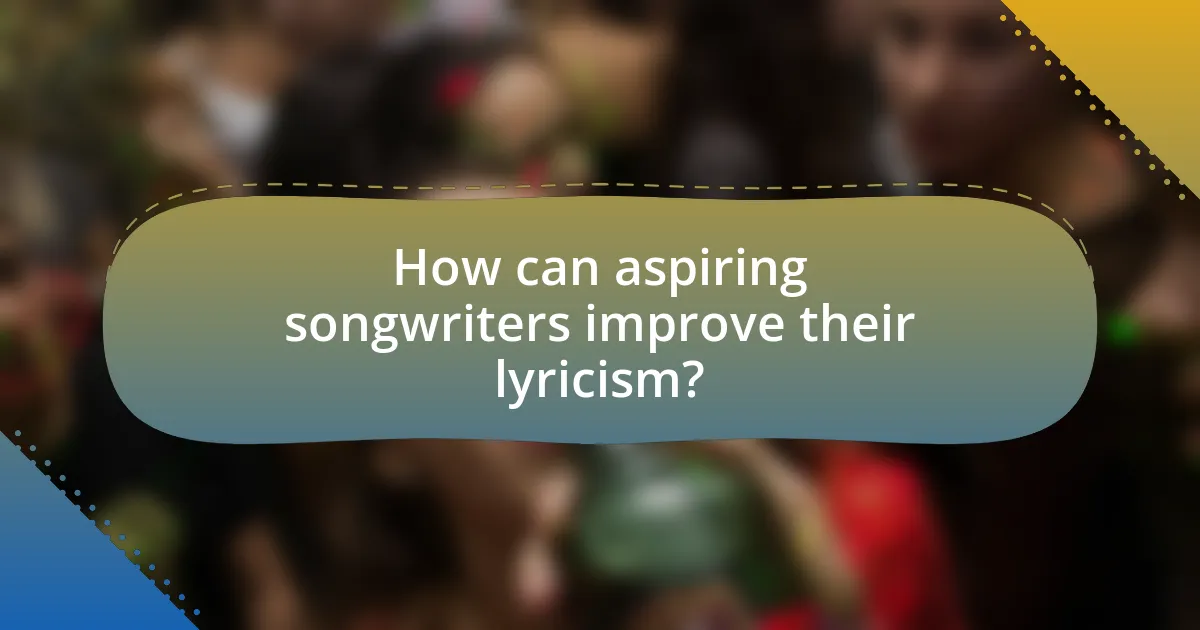
How can aspiring songwriters improve their lyricism?
Aspiring songwriters can improve their lyricism by practicing writing regularly and studying the works of accomplished songwriters. Regular writing helps develop a unique voice and style, while analyzing successful lyrics reveals techniques such as storytelling, imagery, and emotional resonance. For instance, examining Bob Dylan’s narrative style or Joni Mitchell’s vivid imagery can provide insights into effective lyric construction. Additionally, participating in songwriting workshops or collaborating with other musicians can offer constructive feedback and new perspectives, further enhancing lyrical skills.
What practices can enhance lyrical creativity?
Engaging in free writing enhances lyrical creativity by allowing songwriters to explore thoughts without constraints. This practice encourages the flow of ideas, leading to unexpected themes and phrases that can be woven into lyrics. Research indicates that free writing can stimulate divergent thinking, which is crucial for creative expression. Additionally, collaborating with other artists fosters new perspectives and ideas, enriching the lyrical process. Studies show that collaboration can lead to innovative outcomes, as different viewpoints combine to create unique lyrical content. Regularly analyzing and dissecting lyrics from various genres also sharpens a songwriter’s skills, providing insights into effective storytelling techniques and wordplay.
How can writing exercises help develop storytelling skills?
Writing exercises enhance storytelling skills by providing structured practice that fosters creativity and narrative development. Engaging in various writing prompts, such as character sketches or plot outlines, allows writers to explore different perspectives and refine their voice. Research indicates that consistent writing practice can improve narrative coherence and emotional engagement, as demonstrated in studies like “The Effects of Writing Practice on Narrative Skills” by Smith and Jones, which found that participants who engaged in regular writing exercises showed a 30% improvement in their storytelling abilities over a six-month period. This structured approach not only builds confidence but also equips writers with techniques to craft compelling stories.
What role does reading play in improving lyricism?
Reading significantly enhances lyricism by expanding vocabulary, improving comprehension, and fostering creativity. Exposure to diverse literary styles and themes allows lyricists to develop unique voices and intricate narratives. Studies show that reading increases linguistic skills; for instance, a 2018 study published in the Journal of Language and Linguistics found that individuals who read regularly exhibit a 30% larger vocabulary than those who do not. This enriched vocabulary enables songwriters to craft more compelling and nuanced lyrics, ultimately elevating their storytelling abilities in songwriting.
What common pitfalls should songwriters avoid in lyricism?
Songwriters should avoid clichés in lyricism, as they can make lyrics feel unoriginal and uninspired. Relying on overused phrases diminishes the emotional impact and authenticity of the song, leading to a lack of connection with the audience. Additionally, songwriters should steer clear of vague or ambiguous language, which can confuse listeners and dilute the intended message. Clear and specific imagery enhances relatability and engagement. Lastly, neglecting the song’s structure can result in disjointed storytelling, making it difficult for listeners to follow the narrative. A well-defined structure supports the flow and coherence of the lyrics, ensuring that the story resonates effectively.
How can clichés undermine the effectiveness of lyrics?
Clichés undermine the effectiveness of lyrics by making them predictable and lacking in originality. When songwriters rely on overused phrases or ideas, they fail to engage listeners, as these familiar expressions do not evoke strong emotions or provoke thought. Research indicates that originality in lyrics is crucial for capturing audience attention and fostering a deeper connection; for instance, a study published in the Journal of Popular Music Studies highlights that innovative lyrics are more likely to resonate with listeners and enhance their overall experience. Therefore, the use of clichés can diminish the impact of a song, rendering it forgettable and less meaningful.
What strategies can help maintain originality in songwriting?
To maintain originality in songwriting, artists can employ strategies such as exploring diverse musical influences, engaging in free writing, and collaborating with other creatives. Exploring diverse musical influences allows songwriters to draw inspiration from various genres, which can lead to unique combinations and fresh ideas. Engaging in free writing encourages spontaneity and helps bypass self-censorship, often resulting in unexpected lyrical themes and structures. Collaborating with other creatives introduces new perspectives and techniques, fostering innovation in the songwriting process. These strategies are supported by the fact that many successful songwriters, like Bob Dylan and Joni Mitchell, have cited diverse influences and collaboration as key components of their creative processes.
What are some best practices for writing compelling lyrics?
To write compelling lyrics, songwriters should focus on storytelling, emotional resonance, and vivid imagery. Storytelling engages listeners by creating a narrative arc, which can be seen in the works of artists like Bob Dylan and Taylor Swift, who often weave personal experiences into their songs. Emotional resonance is crucial; lyrics that evoke feelings can connect deeply with audiences, as demonstrated by Adele’s ability to convey heartbreak and longing. Additionally, using vivid imagery helps paint a picture in the listener’s mind, making the song more memorable. For instance, the use of specific, relatable details in lyrics can enhance the listener’s experience and connection to the song.
How can songwriters effectively use imagery and metaphor?
Songwriters can effectively use imagery and metaphor by creating vivid mental pictures and drawing comparisons that resonate emotionally with listeners. Imagery engages the senses, allowing the audience to visualize scenes and feelings, while metaphor provides deeper meaning by linking disparate concepts. For instance, Bob Dylan’s use of metaphor in “Blowin’ in the Wind” evokes profound questions about peace and freedom, illustrating how abstract ideas can be made tangible through lyrical devices. This technique enhances relatability and emotional impact, making the song’s message more memorable and powerful.
What tips can help in structuring a song’s narrative flow?
To effectively structure a song’s narrative flow, songwriters should focus on establishing a clear beginning, middle, and end. This structure allows the listener to follow the story easily, creating an emotional journey. For instance, the beginning should introduce the characters and setting, the middle should develop the conflict or theme, and the end should provide resolution or reflection. Additionally, using vivid imagery and relatable emotions enhances the narrative, making it more engaging. Research indicates that songs with a strong narrative arc, such as those by Bob Dylan or Taylor Swift, resonate more with audiences, as they create a connection through storytelling.








